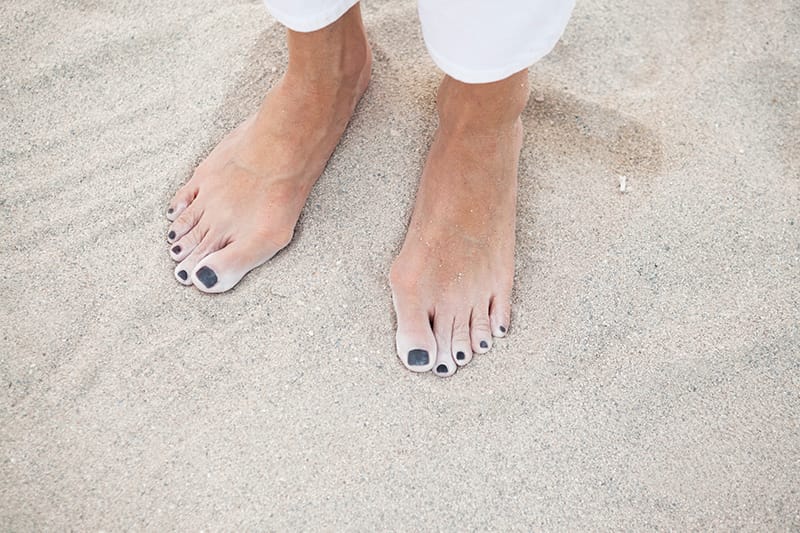Your feet are under a lot of pressure. They bear the full weight of your body, take a pounding when you exercise and contort to fit into shoes to fit your fashion sense.
That last one is easily avoidable. You can prevent a major foot problem simply by wearing shoes that fit properly. Yet 30 percent of people don’t and end up with a painful bunion. And once it forms, you’re left searching for relief so that you can walk and wear shoes again without pain.
What is a bunion?
From your perspective, as you stare down at your feet, a bunion is the bony bump at the base of your toe. But not just any toe. Bunions can only form on the outside of your feet, where the pressure from ill-fitting footwear squeezes your feet. On your big toe, it’s just the common bunion. On your pinky toe, it’s called a tailor’s bunion or a bunionette.
Bunion on the Big Toe
The bunion doesn’t actually form on your big toe, but at the base of it in the joint that connects to the metatarsal bone of your foot. Your metatarsal shifts toward the outside of your foot while your big toe bones angle in the opposite direction toward your other toes. The joint gets inflamed and gets bigger until there’s a red, swollen lump on your foot and lots of joint pain in your big toe.
The bigger it gets, the more painful it is to walk, bear weight or put on shoes. It can be hard to move your big toe or even your entire foot. You might feel a numbing or burning sensation in your joint. And as the shape of your foot changes, you may find it harder and harder to find shoes that comfortably fit over your bunion.
Tailor’s Bunion
A bunion on your pinky toe is similar, but it’s not nearly as common as a bunion on the other side of the foot. Tailor’s bunions got their name because it was a common issue among tailors. They often sat with their legs crossed and the outside of their feet rubbing against the ground all day. This little toe bunion gets irritated and inflamed when wearing shoes.
It can’t just be shoes. What else causes bunions?
A lot of times, it is the shoes, which is why bunions are much bigger problem for women. Years of cramming your feet into shoes that don’t fit or that have a narrow, pointed toe box changes the structure of your foot. Your big toe starts pointing toward your other toes, fitting the narrow shape of the shoe. The same thing can happen with your pinky toe. It bends inward and might even curl underneath.
You can also get bunions from your parents. Some people just have a foot structure that is more likely to form bunions. Other conditions increase your odds of developing bunions too:
- Rheumatoid arthritis (RA) – A foot deformity is often the first sign of RA. The autoimmune disorder affects the bones and joints as well as the ligaments, which weakens the structure of the foot enough to change its shape.
- Overpronation – Your gait can affect your foot shape. If you naturally have a low arch or don’t bear weight evenly across your foot when you move, it makes your toe joints unstable. Overpronation is easily corrected with shoes or shoe inserts so you can prevent bunions and other leg problems that result from the issue.
- Hypermobility – Sometimes, your big toe bone just moves more than usual. If it does, it’s easier for it to lose shape and structure, resulting in a bunion.
- Foot injuries – Any time you damage the structure of your foot, it can cause weakness, pain and change in other parts of the foot.
“Bunions are progressive and can become increasingly painful," says foot and ankle surgeon Dr. Eric Barp. Often times it is good to get baseline radiographs and have discussions about the options that exist with bunions.”
What can I do to relieve bunion pain?
Once a bunion forms, it’s permanent. If it’s not too bothersome, you can take some measures to relieve the pain and inflammation and go on living without any issues.
That starts with the shoes. Get some that fit around your deformity and provide support as well as comfort. Properly-fitting shoes leave plenty of space for your toes and the widest part of the foot, where bunions form. They should also offer good arch support. High heels don’t offer any of this.
Take a look at your worn shoes, especially flats or running shoes. If the soles are unevenly worn, with most of the wear and tear on the big toe or the inside at the ball of the foot, that means you overpronate. Find some athletic shoes that are designed to correct this or get custom insoles for all your shoes that give you the proper support. You can also work with a foot and ankle specialist or physical therapist to strengthen your feet and alter your stride.
Adjusting your footwear will help reduce the pain but may not get rid of it. To manage the bunion pain, take ibuprofen or naproxen and ice your feet to reduce swelling and inflammation.
If none of that helps, do I have to get bunion surgery?
Bunions are a permanent deformity. You can’t take conservative measures to return the shape and structure of your foot back to its normal state. The only way to do that is through bunion surgery.
To truly resolve your bunion pain, you have to remove it entirely. That’s what happens in a bunionectomy. A foot and ankle surgeon removes the bump that protrudes from your foot and moves the misaligned toe and foot joints back into position. Schedule a consultation with a podiatrist to assess your bunions and figure out if bunion surgery is right for you.


